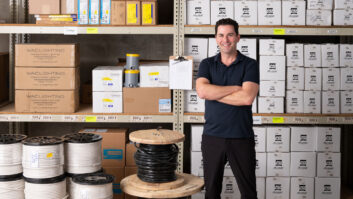Cedia Offers Strategic Roadmap During Arizona Management Conference
The goal was to help attendees create a strategic plan for their businesses, but the CEDIA Management Conference offered much more than that during three intense days at a desert resort

The CEDIA Management Conference was held at the Carefree Resort & Villas, but the tone of the event was hardly that. in Carefree, Arizona, in early March. CEDIA’s roster of strategic management forum instructors, “crossindustry” lecturers, and keynote speakers provided nearly 180 Management Conference attendees with business performance tips, sometimes-sobering housing statistics, and promising predictions about energy management opportunities and shifting customer demographics that bode well for the future of the electronic systems contracting industry.
Each session of the Management Conference was designed to relate to a different element of the one-page strategic plan (see sidebar), a document that attendees were encouraged to begin creating for their own businesses at the conclusion the conference. The hope was that attendees would leave with a firm tactical plan and the inspiration to implement it.
FIRST, THE INSPIRATION
The opening-night keynote on March 4 featured Richard Tait, co-creator of the board game Cranium, who emphasized the importance establishing core values for your company. He encouraged business leaders to create their own value statement and to measure all major management decisions against this list. He referred to his “10 Steps to

CEDIA CEO Utz Baldwin got things rolling at CEDIA Management Conference in Carefree, Arizona. the Next Big Idea” (visit boomboombrands. com/tensteps. php) as the methodology that drives his own consulting business. For more on Tait, read Jeremy Burkhardt’s analysis on p. 30.
THEN, THE PERSPIRATION
On the morning of Day 1 of the conference, business valuation expert John Mack provided a harsh wake-up for any electronic systems contractors (ESCs) in the audience who ever thought they had created an effective exit strategy from their company. “This is probably the worst time to sell your business that I’ve ever seen,” Mack said.
Mack, from the investment firm Imperial Capital LLC, said that ESC businesses are typically unattractive acquisition targets because most are sub-$10-million businesses with relatively slow growth rates.
Mack was not all gloom and doom, however, as he encouraged ESCs to develop a recurring revenue model, such as a service program for completed projects. Taking this proactive approach, he said, could add value to an ESC business and show that the owner is taking initiative during tough economic times. “If you can come out of this economic downturn showing that you can grow, then the surviving players will be better

As usual, networking time was an essential ingredient to the conference. Here, conference committee member Terence Murray of AudioVisions discusses the day’s events at an evening cocktail reception. acquisition targets in the future,” he noted.
Closing out Day 1 was keynote speaker Tim Costello who analyzed daunting U.S. housing statistics that seemed to predict a prolonged “correction” of grossly over-inflated housing prices for at least the next two to four years. Costello cited reports that said that by 2013, more than 50 percent of all mortgages in the U.S. would be “under water.”
“This is not a half a million too many homes on the market. It’s really three million,” he said of the construction surplus.
And, Costello said, the mental toll of the recession will be a difficult hurdle to overcome, even as spending resumes. “We have one of the largest wealth destruction periods in our time,” he said, “and that can’t help but affect the psychology of American consumers going forward.”
Costello noted that a huge demographic shift of baby-boomers from their peak-earning years to retirement by 2015 will offer a challenge and opportunity for ESCs who can adjust to their changing needs for value-oriented entertainment solutions as well as home healthcare technologies. Another opportunity for ESCs, he said, is finding a way to package technology solutions for the next generation of tech-savvy consumers— Generation Y.
GREEN OPPORTUNITIES
The morning of Day 2 featured presentations from architect Jennifer Siegal, who focuses on sustainable, pre-fabricated, and modular housing designs and Rick Simpson, who gained prominence in the ESC channel when he served as the lead integrator on Chicago’s Museum of Science and Industry Smart Home project.
Siegal encouraged ESCs to form co-branding partnerships with green technology providers, such as solar panel suppliers. She also noted that architects, like herself, who serve as gatekeepers on these types of projects, love for their partners to make it easier on them by offering a package of technology solutions. Although her work with AV technology has thus far been

Rick Simpson, an integration professional focused on “green” projects, pointed out that some of the most basic ESC offerings, like lighting, HVAC control, energy monitoring, and digital signage, can help a builder earn as many as five valuable LEED points on a project. limited, Siegal’s modular homes are unique in that all installation must be performed at the factory where the home is being assembled. Her prefab designs are then dropped into place, fully formed, at the construction site.
The audience responded warmly to Simpson, who provided the most optimistic perspective for ESCS looking for a silver lining in the down economy. He explained how enthusiastic builders in Chicago have been about working on LEEDcertified construction projects. He also pointed out that some of the most basic ESC offerings, like lighting, HVAC control, energy monitoring, and digital signage, can help a builder earn as many as five LEED points on a project. “It’s nothing we haven’t done before, but we have to present it differently,” he said.
Simpson’s company, 3G Applied Technology, has made “Green-branding” a priority by reworking its company logo, slogan, business cards, and website, and even presents two different proposals—one “regular” and one “Green”—on projects. The Green one, Simpson noted, almost always gets the nod over the regular one, even if it costs more.
LEED Gold and LEED Platinum, Simpson said, are the Holy Grail for Green builders, but the technology integration portion of those projects is not as well defined as other elements. “There are rules in these certifications about demonstrating a significant reduction in energy consumption,” Simpson said. “We’ve been able

Sugar Ray Leonard served as the closing night keynote speaker and friendly sparring partner to Stewart Filmscreen’s Joaquin Rivera. to fit into the “Innovation in Design” category by integrating efficient speakers, using products with amplifiers that draw less than a watt at standby, integrating IP control, and installing kiosks that educate about the differences between conventional concepts and Green design.”
ACCOUNTING TIPS AND BOXING WISDOM
Jim Weber, a straight-shooting financial accountant, led off the morning on Day 3 with a session called, “Fire Your Accountant.” Weber offered a series of rhetorical questions related to financial management of ESC firms, asking the audience specific question about their tax reporting structure and other strategies that might be missed on the bean-counting side of their businesses.
Among his broader points, Weber discouraged real-estate partnerships, but said that if you must share a building, then you should never be the richest person in the partnership. Weber’s innovative staff retention suggestion was the creation of a deferred compensation plan for an employee that remains with the company for 10 years. “This helps discourage your best guys from leaving and becoming your competitor,” he said.
Weber concluded his session by saying, “Don’t fire a good accountant, but challenge yourself to find a good one and challenge them. Let them go if you’re not the most important client to them.”
Closing out the major presentations of the 2009 CEDIA Management Conference was famed boxer Sugar Ray Leonard who provided a light-hearted memory and video tour of his illustrious career. He focused

SpeakerCraft president Jeremy Burkhardt encouraged note taking during the openingnight keynote address. on the metaphor that surviving in the business world is a lot like a physical fight in the ring, and that to win you have to do your daily “road work”. “For me it was a five-mile run at five a.m. every day,” he said. “Maybe for you it’s going to work an hour earlier or leaving two hours later. Determination gives you a mental edge. You must do what your competitors aren’t doing.”
The Olympic gold medalist and multiple title holder encouraged his CEDIA Management Conference audience to study their competitors’ strong and weak points, and to be organized, specific, and confident in their competitive assault.
Self-esteem, he said, can be the most illusive ingredient of a successful fight, in the ring or in life. “It takes a holiday when you need it the most,” he said. “But, always believe in yourself.”
To illustrate his point, Leonard recalled a sparring injury that he suffered just a few weeks prior to his historic fight with Tommy Hearns. Leonard’s support team was visibly shaken, he said, by his sudden vulnerability to a much-less-challenging sparring partner. But, because he believed in his own ability and understood how he could adjust his strategy, the fight was won.
Jeremy J. Glowacki is editorial director of Residential Systems.







